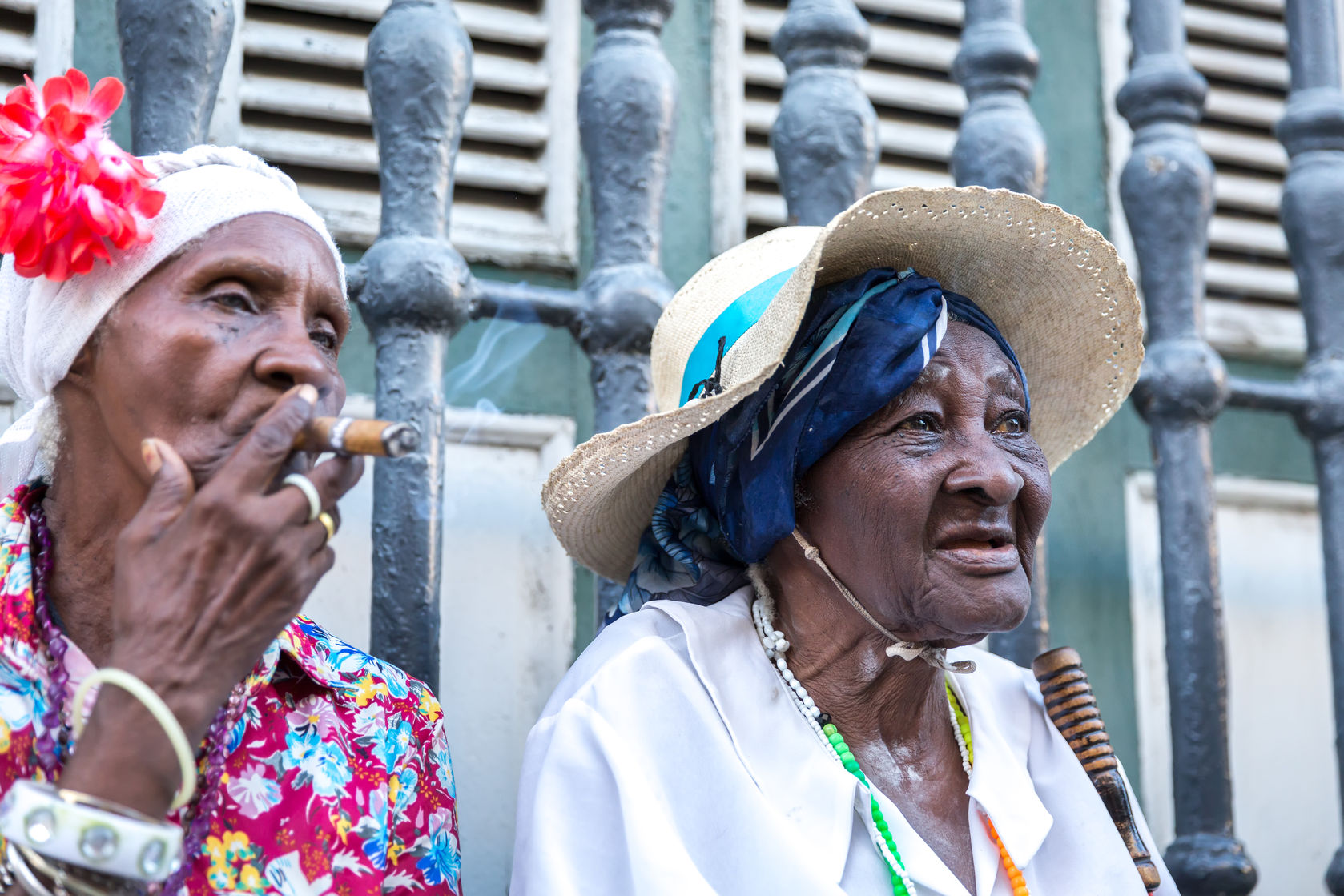
Two women in Cuba smoking cigars.
WE ALL KNOW that feminism, in its simplest form, is defined as the belief that men and women should have equal rights. Some definitions go on to specify that these include political, economic, social, and personal rights, and prescribe the methods by which they should be achieved. From eco-feminism to radical feminism, there are many schools of thought and forms of practice, and they continue to emerge as we learn more about the world we live in, the world we want, and the specific actions that will take us from one to another. Caribbean feminism encompasses the concept of intersectional feminism, while specifically focusing on the regional context which demands particular attention on race, color, language, class, religion, and cultural practices.
Caribbean feminists have no choice but to be intersectional. The Caribbean identity itself is layered with origin, language, and a host of other personal, national, and regional markers linked to colonization, slavery, emancipation, industry, and economic status. Caribbean people do not have the luxury — or the misfortune — of believing that environments and systems are imperfect due to a single issue. Diversity in demographic, culture, and lived experience make it impossible to divorce current circumstances from the storied histories and complexities predicated on them. This perspective drives the feminist agenda, and ongoing work on the treatment of feminine bodies, organizing, masculinity, and culture.
Feminine Bodies
Women’s bodies — in Caribbean countries and elsewhere — have long been sexualized, and Caribbean feminism has been a force, fighting for recognition of women’s rights to self-determination. Caribbean feminism has fought against patriarchal ideas about the body and rape culture narratives.
Many Caribbean nations celebrate and promote carnivals — welcoming nationals and tourists to participate in street parties with music, liquor, costumes, and dancing. Carnival provides a space for people to free themselves of expectations enforced by respectability politics. They can wine in bikini costumes without interference or misinterpretations about intentions or motives.
Carnival has given Caribbean feminists a reference point for conversations about bodily integrity and the issue of equating women’s whole beings with their representation at one moment in time. It makes a distinction between a chosen activity and conclusions drawn by other parties, and this is made clear in the Not Asking For It campaign. It has helped to open conversation about the implications of moving through the world in feminine bodies, and how it must be considered as we shape conversations about gender relations.
Organizing
Caribbean feminist organizing is inclusive, responsive, and intentional in ways that North American feminism has not been. It carefully considers the intersections of gender, race, and sexuality, leaving no room for single-issue work. When Caribbean feminists create spaces, it is with consciousness of privilege and environment. There are considerations of ability to travel and disposable income. How quickly and easily can people acquire travel visas? What is the cost of travel? Is there funding for others to participate in regional dialogues? How can we accommodate those for whom English is not their first language? These are real, recurring questions that must be answered before regional work can be undertaken.
This ability to organize inclusively partially has it roots in the radicalization of the feminist and nationalist movements of the late 20th century. According to writer and activist Amílcar Sanatan, “during the 1980s, there were a series of encuentros intra-regionally building transnational feminist networks between Latin America and the Caribbean. Accounting for inclusion and committing to ‘making politics work’ in encuentros […] the space offers an example to a younger generation of Left movement builders that non-hierarchical, coalition-based, and inclusive conferences […] sustain in the long-run and build greater solidarity.” The challenges of living in a region where race, identity, nationalism, and culture are so inextricably bound together have actually gifted Caribbean feminists with an almost-inherent ability to recognize, acknowledge, and extrapolate intersecting identities and the wide range of experiences that we may not all share — and then take effective action.
Masculinity
While issues of masculinity need to be explored everywhere, in the Caribbean, it must be viewed in the context of plantation living. Today’s Afro-Caribbean people are descendants of yesterday’s slaves, and carry with them the learning of their ancestors. Men, stolen from their homes, subjugated, dominated, abused, and made to toil while being brainwashed with a convenient brand of Christianity were limited in expression of masculinity. They learned to assert themselves through brute strength in the fields, and hypermasculinity in the home that manifested — and continues to manifest — itself in various ways which include violence. This has not only affected black men, but LGBT+ people who do not live within the confines of gender. Violent expressions of masculinity pervade LGBT+ communities of color through masculine-presenting people, impacting feminine-presenting people in a variety of ways. Caribbean feminism recognizes and responds to this, and it links gender-based violence and other symptoms of hypermasculinity to its source — slavery and the anti-blackness that persists post-emancipation. Intersectional organizations, like Guyana’s Society Against Sexual Orientation Discrimination (SASOD), work to combat the social ills that hypermasculinity perpetuates.
Dancehall Culture
Caribbean feminists are required to be cultural critics. While participating in traditional events and celebrating various aspects of Caribbean culture, feminists in the region have the responsibility of responding to anti-women sentiments that present themselves in a myriad of ways. Music is one of the most foremost ways that anti-feminist messaging is spread, disguised as something else. Dancehall music, much like American hip-hop, perpetuates problematic gender norms: it often features women as objects — existing for the gratification their bodies bring to men — denounces homosexuality, and holds women to impossible and conflicting standards of moral purity and physical attractiveness. Mr. Vegas, a popular dancehall artist, is particularly vocal about his distaste of any woman he deems a “ho,” and his lyrics, along with the lyrics of countless other popular artists, encourage men to forego consent and impose themselves upon women in dance. Caribbean feminists are left with the difficult job of leading discussions on the problematic nature of the themes in many of the most popular songs both past and present, and the reality they help to construct.
There can no be question that Caribbean feminism is intentional, active, and intersectional in both definition and practice. Feminists in the Caribbean engage in national and regional conversations that go to the fabric of their societies. They do not champion only the rights of women, but people of all genders, races, and sexualities, because none can be separated from the other. Just as Caribbean lives are multilayered, so is Caribbean feminism, activism, and advocacy. North American feminism, which has long been accused of being overwhelmingly white and myopic, would do well to take note of the lessons it can learn from its Caribbean counterpart.



-300x169.jpg)












